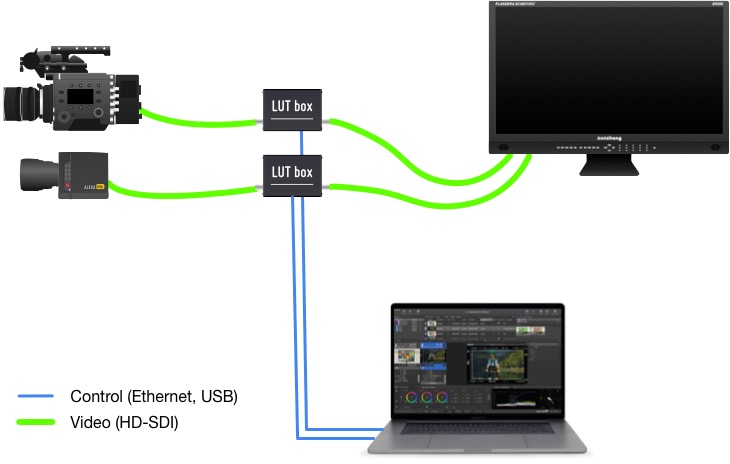Basic hardware setup with Livegrade and LUT boxes
Video Signals on Set
Typical digital film cameras on a film set have HD-SDI outputs for external display and processing of the live image. In comparison with other video standards, HD-SDI has the following advantages:
- HD-SDI allows long cable length (e.g. 30m – 100m for 1080p, depending on cable type), and
- HD-SDI is easily routable and switchable.
Usually the live signals of all cameras on set end up at a DIT cart or similar setup for monitoring, inspecting, and further processing.
Basic Device Requirements
For most use cases a setup with Livegrade is built on top of an existing HD-SDI monitoring setup. You will need:
- HD-SDI signals (via BNC cables) coming from the cameras on set, and
- a good and calibrated HD-SDI monitor of decent size (e.g. 24 inch) with 1-2 HD-SDI inputs.
Livegrade uses LUT boxes for processing the live signals. A LUT box is a device with one (or more) HD-SDI inputs and one (or more) HD-SDI outputs. When powered up, the device applies a lookup table (LUT) when the signal passes through. Livegrade controls that LUT and thus controls the appearance of the live image.
Using LUT boxes for processing has the following advantages:
- Hardware solution for signal processing: If the computer with Livegrade is closed, shut down, or restarted, the signal is still being processed in the LUT box (with the last loaded LUT).
- Scalable multi-channel setup: Adding one more HD-SDI signal channel to the setup can be achieved by simply adding one more LUT box. As the computer running Livegrade is not busy with processing any image (as this is done in LUT boxes), a setup with for example six live signals being processed at the same time can be implemented with a notebook running Livegrade and six LUT boxes for the signal processing.
Additional Features of LUT Boxes
In addition of applying a LUT, some LUT boxes have additional features:
- Time Code: Some LUT boxes can provide time code to the software. This helps when looks are stored in the software, as an associated timecode can help match the looks to recorded clips later, e.g. for dailies creation.
- Framegrabs: Some LUT boxes can provide framegrabs to the software. This helps to store visual references in Livegrade for alter review and comparison, or simply as a visual reference when transferring looks to post production.
- Camera Metadata: Some LUT boxes can provide camera metadata from the ancillary (ANC) data parts of the HD-SDI signal. This metadata allows to monitor camera settings within Livegrade, and can also act as reference information for later shooting days.
More Options For HD-SDI Connectivity
For information about additional HD-SDI setup options with Livegrade please see the article HD-SDI Setup Options.
The following topics are covered there:
- Using HD-SDI capture devices in the application for framegrabs and recording.
- Using HD-SDI output devices for viewing reference material and live signals on HD-SDI.
- Controlling an HD-SDI router from the application.
